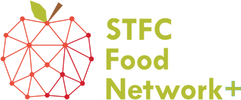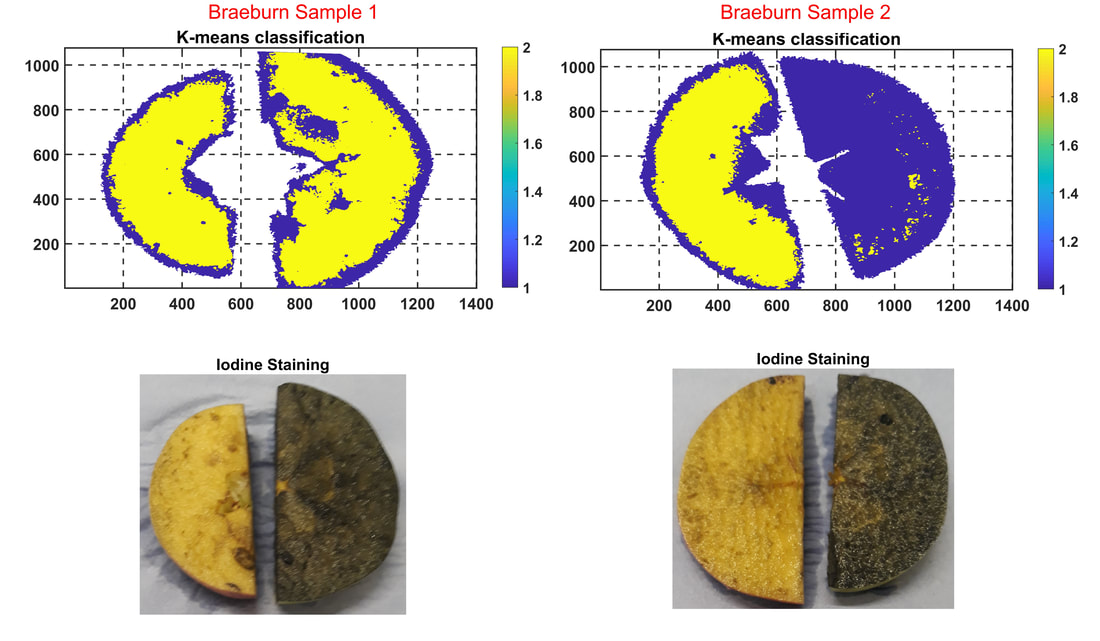|
A new approach to measure fruit ripening could help increase quality and reduce waste for apple growers The apple has long been one of the most popular fruits eaten in Britain, with the UK market worth more than £220 million each year. But few people realise that the juicy, ‘fresh’ apple they buy at the supermarket may have been in cold storage for nearly a year. Timing the apple harvest to ensure long-lasting, delicious fruits is a real challenge for farmers – but one that could soon become easier thanks to research supported by the STFC Food Network+. "Two examples of Braeburn apple samples where multispectral imaging has been tested to see if it can distinguish parts containing starch (stained dark by iodine) from areas where starch had broken down into simple sugars (no staining). As the technology is still in development, the multispectral results are not yet clear for all samples. Photo credit: Deborah Rees and Melina Zempila." “Most apples are harvested in autumn, but the demand for them lasts all year round” says Deborah Rees, who describes herself as a ‘post-harvest’ biologist at the Natural Resources Institute (University of Greenwich). “This means we have to find a way to slow down the deterioration process and keep them in good quality”. Typically, this involves storing them at a low temperature (between 0.5 and 3°C depending on the variety), in a modified atmosphere with low oxygen levels. But even under these conditions, apples continue to ripen. “The longer you want to store apples, the earlier you have to pick them, so the window for harvesting is very narrow” says Deborah. “Growers currently have very little advance notice of this, so it can be a nightmare to recruit enough labour”. This can ultimately lead to waste if fruit cannot be picked at the right time. To address this, Deborah is researching a new approach to capturing the ripening process as it happens.
As fruits ripen, complex starch molecules are converted into simpler sugars, developing the sweet taste we enjoy. This can be measured using potassium iodide dye (iodine), which turns blue-black in the presence of starch. “Many people remember doing iodine staining at school, for instance staining leaves to look at starch production during photosynthesis or to compare the starch levels in different vegetables” Deborah says. “Apple growers use exactly the same process, typically in the boot of a car, right in the middle of the orchard. It’s messy, time consuming and not particularly safe considering that iodine is a hazardous substance”. Deborah hopes this could be replaced with a method based on multispectral or hyperspectral imaging. These methods use wavelengths beyond the visible light spectrum, including ultra-violet and infra-red light. In the case of hyperspectral imaging, hundreds or even thousands of narrow bands (10-20 nm) can be analysed. “The resulting image depends on what wavelengths are absorbed by the sample, which is affected by the chemical composition” says Deborah. “What we wanted to find out was if we could find a signal signature that depended on the concentration of starch.” To investigate this, Deborah and her colleagues collaborated with an apple grower in Kent during the harvest season. “We took cut slices from apples at different maturities and compared the iodine-stained slices with images taken using two hyperspectral cameras to identify promising wavelengths” she says. Once the apple harvest was over, they continued to refine the signal processing method using bananas, since these also ripen when starch molecules convert to sugars. “These were a good substitute model for apples since most bananas are imported immature and then artificially ripened using the plant hormone ethylene” says Deborah. The initial results indicate that hyperspectral imaging shows promise for measuring apple ripening, particularly for wavelengths in the range 460 – 630 nm, 630 – 920 nm. “A particular advantage is that the data give a quantitative readout, whereas iodide staining can only indicate presence or absence of starch” says Deborah. “This could provide a more informative and earlier measurement of starch breakdown.” She uses the analogy of an emptying bathtub, where iodine staining would only tell you when the tub was completely empty. “A quantitative method, on the other hand, can tell you when the tub is half-empty” she says. The next challenge will be to develop a portable multispectral (or hyperspectral if necessary) instrument that could be used directly by farmers on the orchards, without complex training. According to Deborah, some of the UK’s major apple growers have already shown interest. Nigel Kitney of the agricultural and horticultural advice company Hutchinsons says “this is an exciting development which will remove the subjectivity of the starch iodine test enabling growers to harvest the apples at the correct time, improving the product’s consistency for the consumer”. Besides providing funding, the STFC Food Network+ enabled Deborah to connect with researchers at RAL Space who were experts in spectroscopic methods and data analysis, including planetary scientist Hugh Mortimer and a research scientist, Melina Zempila. “Normally they would work on processing satellite data, so it was an opportunity for them to apply their skills to a very different sector”. In addition, her attendance and presentation about the project at the Network’s annual meeting opened up a discussion about a whole range of other potential technologies and fruits to consider. Having worked with apples for over 10 years, it is perhaps not surprising that Deborah enjoys eating them too. “My favourite has to be the Russet apple, although the Bramley is of course the best for a good apple crumble” she says. “I seem to be surrounded by apples all the time at the moment. Even when I go out cycling, it’s usually through the Kent apple orchards!”
0 Comments
Your comment will be posted after it is approved.
Leave a Reply. |
AuthorJune 2024 - Archives
June 2024
Categories |
- Home
- Webinars and Events
- About the SFN+
- News
- Blog
- Expert Working Groups
- Funding
-
Publications
- Bioeconomy positioning paper
- SFN+ 5th Annual Conference
- OMM Policy Report
- ‘Multi-Stakeholder International One Day Workshop on Organic Agri-Food Value Chains for Net Zero’ Report
- SFN 2050 UK Net Zero Food report
- Sustainable Cold Food Chain Booklet
- Food Sensing Technologies for Safe and Nutritious Food
- Sustainable urban and vertical farming
- Projects
- Join/Contact Us


 RSS Feed
RSS Feed


